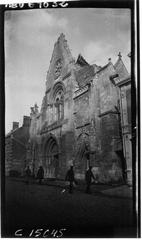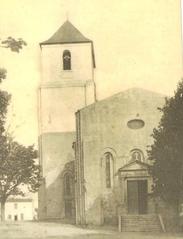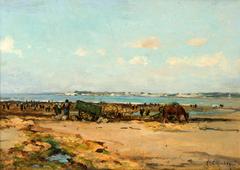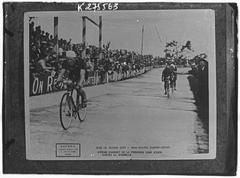Temple de Maine-Geoffroy, Royan, France: Visiting Hours, Tickets, and Historical Sites Guide
Date: 04/07/2025
Introduction: History and Cultural Significance
Nestled in the picturesque coastal town of Royan in southwestern France, the Temple de Maine-Geoffroy stands as a profound emblem of Protestant heritage, resilience, and cultural identity. Established in 1756 during the era of clandestine Protestant worship—known as the “Église du Désert”—the temple originally occupied a converted barn, reflecting both the discreet circumstances under which Protestants gathered and the humble origins of their community (fr-academic.com; Patrimoine Royan).
Built with local limestone and rubble masonry, the temple’s unadorned rectangular structure and restrained design exemplify Protestant values of simplicity, emphasizing scripture and communal worship over ornamentation (Wikipedia). As the only publicly owned former “maison d’oraison” in the Arvert peninsula, the Temple de Maine-Geoffroy remains a powerful symbol of religious perseverance and architectural modesty.
This guide provides a comprehensive overview for visitors: from its rich history and unique architecture to practical details such as opening hours, guided tours, accessibility, and nearby attractions. Whether you are a history buff, an architecture enthusiast, or a traveler in search of meaningful experiences, this article will help you make the most of your visit to this exceptional Royan historical site (Maison de l’Histoire du Protestantisme Charentais; Royan Tourist Office).
Table of Contents
- Introduction: History and Cultural Significance
- Historical Overview
- Exterior and Interior Architecture
- Site Context: Cemetery and Surroundings
- Visiting Information
- Nearby Attractions and Travel Tips
- Architectural and Religious Importance
- Visitor Experience
- FAQs
- Historical Significance and Legacy
- Key Dates and Figures
- Related Royan Historical Sites
- Plan Your Visit
Historical Overview
Origins and Early Context
The Temple de Maine-Geoffroy originated in 1756, at a time when the Protestant faith was practiced in secrecy. The era of the “Église du Désert” saw local congregations gather in hidden locations—often barns or private homes—to avoid persecution (fr-academic.com). In Royan, the clandestine community was guided by pastors such as Louis Gibert and Jean Jarousseau, the latter known as the “Pasteur du désert.” The brief relaxation of restrictions at the start of the Seven Years’ War allowed for the discreet establishment of a physical temple.
Construction and Features
The temple’s humble structure, originally a converted barn, features a simple rectangular nave, round-arched windows, a low-pitched Roman tile roof, and an east façade inscribed “Maison de Prière.” These architectural choices reflect the Protestant ethos of humility and functionality (fr-academic.com; Wikipedia).
Community Role and Evolution
From 1756 to 1784, the Temple de Maine-Geoffroy served as the sole official Protestant worship site in Royan. After a new temple opened in the city center in 1784, some congregants continued to use Maine-Geoffroy, valuing its historical significance (Maison de l’Histoire du Protestantisme Charentais).
Renovations in 1828, led by architect Daniel Marrion, preserved the integrity of the structure. The temple’s use shifted over the centuries, serving primarily for funerals by the mid-20th century, before being acquired and restored by the municipality in 1996. Since 2001, it has been managed by the Reformed Church council and is currently used by the Baptist Church for weekly services (fr-academic.com; eglises.org).
Exterior and Interior Architecture
Exterior Design and Materials
The temple’s exterior is marked by unembellished walls, local limestone, and rubble masonry, topped with traditional canal tiles (Patrimoine Royan). Its rectangular plan and lack of decorative elements echo the agricultural granges that served as worship spaces during times of repression, reflecting both the modest means and the discreet practices of Royan’s Protestant community (Wikipedia).
Interior Layout and Features
Inside, the Temple de Maine-Geoffroy is equally understated. A single, open hall contains simple wooden pews facing a modest pulpit, with no altar or religious iconography. The whitewashed walls and low beamed ceiling create a tranquil, light-filled space, in keeping with Reformed traditions that prioritize scripture and communal prayer (Patrimoine Royan; temples.free.fr).
Site Context: Cemetery and Surroundings
Set at 2, rue des Coquelicots, the temple is nestled within the former rural edge of Royan, now integrated into the urban landscape (Patrimoine Royan). Adjoining the temple is a small Protestant cemetery, established in the 18th century and containing notable graves from the community’s early years (France-Voyage).
Visiting Information
Location and Access
- Address: 2, rue des Coquelicots, Royan, Charente-Maritime, France (Mapcarta location)
- Getting There: Accessible by foot, local bus, or car from Royan’s city center. Parking is limited nearby.
Opening Hours and Entry
- Visiting Hours: Open to the public during Sunday worship services at 10:30 AM and by appointment at other times. Open additionally for special events such as European Heritage Days.
- Entry: Free of charge, with no tickets required.
Guided Tours and Events
- Guided tours are offered during heritage events or by arrangement through the Royan Tourist Office or Royan parish.
- Special services and cultural events are held throughout the year.
Accessibility Details
- The temple is generally accessible for visitors with limited mobility; however, some uneven ground may be present. Contact the parish in advance for specific needs.
Nearby Attractions and Travel Tips
Enhance your visit by exploring other Royan sites:
- Marché Central de Royan: A modernist market and hub for local produce.
- Église Saint-Pierre de Royan: A historic Catholic church with Romanesque and Gothic elements.
- Royan Beaches: Renowned sandy beaches and scenic promenades.
- Saint-Georges-de-Didonne: A charming coastal village and lighthouse.
- For more, visit the Royan tourism website and Mapcarta’s Royan page.
Travel Tips:
- Check service times and events before your visit.
- Dress modestly and maintain respectful behavior.
- Combine your temple visit with nearby attractions.
- Participate in concerts, lectures, or heritage days for a deeper experience.
Architectural and Religious Importance
The Temple de Maine-Geoffroy exemplifies the enduring presence and resilience of Protestantism in Royan. Its architecture reflects a commitment to humility and community, while its ongoing use by various congregations underscores its living heritage (temples.free.fr; Wikipedia).
Visitor Experience
The temple offers a serene environment for reflection, worship, and cultural discovery. Its understated beauty and tranquil setting, paired with its historical significance, make it a rewarding stop for visitors interested in religious history or local culture.
Frequently Asked Questions (FAQ)
Q: What are the visiting hours?
A: Open during Sunday services at 10:30 AM and by appointment or during special events. Confirm schedules with the parish or tourist office.
Q: Is there an entry fee?
A: No, admission is free.
Q: Are guided tours available?
A: Yes, during heritage events and by arrangement.
Q: Is the temple accessible for people with disabilities?
A: Generally yes, but some areas may have uneven surfaces. Contact the parish for assistance.
Q: What other attractions are nearby?
A: Marché Central, Église Saint-Pierre, Royan’s beaches, and Saint-Georges-de-Didonne.
Historical Significance and Legacy
The Temple de Maine-Geoffroy stands as a monument to Royan’s Protestant past, surviving centuries of religious suppression, revolution, and change. Its continued preservation and use today celebrate religious tolerance and the rich cultural tapestry of Royan and southwestern France (fr-academic.com; Patrimoine Royan).
Key Dates and Figures
- 1756: Temple established in a converted barn.
- 1784: New city-center temple inaugurated.
- 1828: Major renovations by Daniel Marrion and René Janin.
- 1996: Acquired and restored by the municipality.
- 2001: Managed by the Reformed Church council; used by the Baptist Church.
Related Royan Historical Sites
Plan Your Visit
Experience the unique history and peaceful ambiance of the Temple de Maine-Geoffroy. For current information on visiting hours, tours, and special events, consult the Royan Tourist Office or download the Audiala app. Stay updated and join the community online for more insights and recommendations.
Summary and Call to Action
The Temple de Maine-Geoffroy encapsulates centuries of Protestant perseverance, faith, and cultural identity in Royan. Its understated architecture and enduring legacy offer a compelling experience for visitors interested in history, architecture, and religious heritage (fr-academic.com; Patrimoine Royan). Plan your visit around Sunday services or special events, and explore the surrounding attractions for a fuller appreciation of Royan’s diverse heritage (Wikipedia; Royan Tourist Office).
Download the Audiala app for up-to-date information, event notifications, and exclusive content on Royan historical sites. Follow us on social media for news and inspiration.
References
- Temple de Maine-Geoffroy - Historical and Architectural Overview, fr-academic.com
- Maison de l’Histoire du Protestantisme Charentais
- Patrimoine Royan - Temple Protestant de Maine-Geoffroy
- Wikipedia - Temple Protestant de Maine-Geoffroy
- Royan Tourist Office
- Mapcarta - Temple protestant de Maine-Geoffroy
- France-Voyage - Temple protestant Royan



